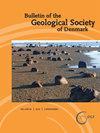Stratigraphy and geothermal assessment of Mesozoic sandstone reservoirs in the Øresund Basin – exemplified by well data and seismic profiles
IF 1
4区 地球科学
Q2 Earth and Planetary Sciences
引用次数: 14
Abstract
The Øresund Basin in the transnational area between Sweden and Denmark forms a marginal part of the Danish Basin. The structural outline and stratigraphy of the Mesozoic succession is described, and a novel interpretation and description of the subsurface geology and geothermal potential in the North Sjælland Half-graben is presented. The subsurface bedrock in the basin includes several Mesozoic intervals with potential geothermal sandstone reservoirs. Parts of the succession fulfill specific geological requirements with regard to distribution, composition and quality of the sandstones. A characterisation of these is presently of great interest in the attempt to identify geothermal reservoirs suitable for district heating purposes. The results presented in this paper include for the first time a comprehensive description of the stratigraphic intervals as well as the characteristics of the potential Mesozoic geothermal reservoirs in the Øresund region, including their distribution, composition and physical properties. This is illustrated by seismic cross-sections and well sections. In addition, results from analyses and evaluations of porosity, permeability, formation fluids and temperature are presented. Six potential geothermal reservoirs in the Mesozoic succession are described and assessed. Primary focus is placed on the characteristics of the reservoirs in the Lower Triassic and Rhaetian–Lower Jurassic succession. The study shows that the Mesozoic reservoir sandstones vary considerably with respect to porosity and permeability. Values range between 5–25% for the pre-Rhaetian Triassic sandstones and are commonly >25% for the Rhaetian–Lower Jurassic and Lower Cretaceous sandstones. The corresponding permeability rarely reaches 500 mD for the pre-Rhaetian Triassic reservoirs, while it is commonly above one Darcy for the Rhaetian–Lower Jurassic and the Lower Cretaceous sandstones. The interpreted formation temperatures are 45–50°C at 1500 m, 60–70°C at 2000 m and 70–90°C at 2500 m depth. The combined results provide a geological framework for making site-specific predictions regarding appraisal of viable geothermal projects for district heating purposes in the region as well as reducing the risk of unsuccessful wells.Øresund盆地中生代砂岩储层地层学及地热评价——以井资料和地震剖面为例
位于瑞典和丹麦之间跨国地区的Øresund盆地构成了丹麦盆地的边缘部分。描述了北Sjælland半地堑的构造轮廓和中生代演替地层,并对其地下地质和地热潜力进行了新的解释和描述。盆地地下基岩包括几个中生代层段,具有潜在的地热砂岩储层。部分序列在砂岩的分布、组成和质量方面满足特定的地质要求。目前,在试图确定适合区域供热目的的地热储层时,对这些特征的描述非常感兴趣。本文首次全面描述了Øresund地区中生代地热储层的层段及潜在储层的分布、组成和物性特征。地震剖面和井剖面说明了这一点。此外,还对储层的孔隙度、渗透率、地层流体和温度进行了分析和评价。对该区中生代演替中的6个潜在地热储层进行了描述和评价。重点研究了下三叠统和雷梯—下侏罗统的储层特征。研究表明,中生代储层砂岩的孔隙度和渗透率差异较大。前雷蒂亚-下侏罗统和下白垩统的三叠纪砂岩通常在5-25%之间。雷蒂亚—下侏罗统和下白垩统砂岩的渗透率一般在1达西以上,而前雷蒂亚—下侏罗统三叠纪储层的渗透率很少达到500 mD。解释的地层温度为1500米处45-50℃,2000米处60-70℃,2500米处70-90℃。综合结果提供了一个地质框架,用于对该地区可行的地热项目进行具体地点的预测,以评估该地区的区域供热目的,并减少不成功井的风险。
本文章由计算机程序翻译,如有差异,请以英文原文为准。
求助全文
约1分钟内获得全文
求助全文
来源期刊

Bulletin of the Geological Society of Denmark
GEOSCIENCES, MULTIDISCIPLINARY-
CiteScore
2.80
自引率
16.70%
发文量
28
审稿时长
>12 weeks
期刊介绍:
The Bulletin publishes contributions of international interest in all fields of geological sciences on results of new work on material from Denmark, the Faroes and Greenland. Contributions based on other material may also be submitted to the Bulletin if the subject is of relevance for the geology of the area of primary interest.
 求助内容:
求助内容: 应助结果提醒方式:
应助结果提醒方式:


